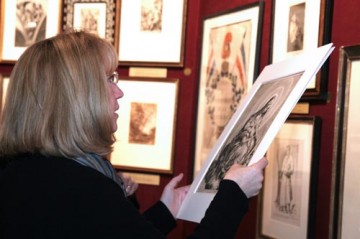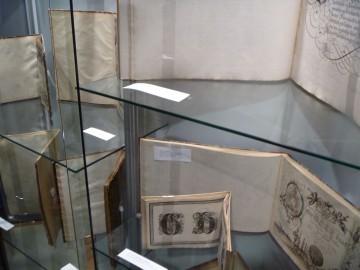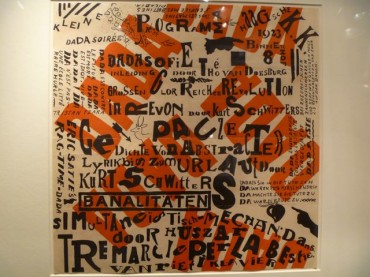An air of refinement hung fairly heavily throughout the old Armory building this weekend with a weighty reminder of the long history of printmaking at the IFPDA Print Fair. Many of the booths such as David Tunick’s, where Rembrandt etchings, Matisse lithographs, Picasso etchings, Edvard Munch drypoints, as well as nine Whistler prints of Venice hung salon-style, could have been plucked from the Drawings and Prints Room of somewhere like the Metropolitan Museum.
Barbara Krakow Gallery featured polygon etchings by Robert Mangold, with deliberate imperfections in his architectural lines and ruptures of bright green and orange bursting out of some of the shapes. Around the corner, Sol LeWitt etchings with aquatint Stars — Light Center in various gradations of gray were similar in tone to James Turrell’s spatial Series E, from 1st Light pieces on the next wall. Krakow also had a print of Philip Guston’s The Street, which seemed to provide an underfoot perspective of the chaotic street scenes depicted in a number of the Max Beckmann prints on the wall opposite at Alice Adam.
In fact, a whole wall was dedicated to Max Beckmann prints at Alice Adam as well as at another booth, Jörg Maass. The former gallery was offering pieces from his earlier period of 1916-22, while Maass had more from between the wars, which are a lot less salacious and no longer depicting a heady glamor. Albrecht Dürer was also as prolific as ever: C.G. Boerner had Dürer’s Melencolia I, Adam & Eve, as well as St. Jerome in his Cell, while R.E. Lewis & Daughter were selling his Joachim and the Angel woodcut from 1554 for $24,000. Five rare Goya etchings were available at Kunsthandlung Helmut H. Rumbler, featuring violent bullfights, the aftermath of warfare as well as his 1797 print Until Death of a decrepit-looking woman adjusting her headdress at her cosmetic table while surrounded by her servants.
Crossovers with the book fair at PS1 were also apparent: Sims Reed had a booth at each fair (with prints here by Picasso, Matisse, Braque, multiple Hockney’s as well as Ed Ruscha’s vibrant pastel work Cheese Mold Standard with Olive). Rare dada and Bauhaus books were available from the antiquarian bookseller Ars Libri; and Ursus Books were selling Warhol’s A Gold Book (from his pre-Pop period yet revealing his early fascination with images of wealth) for $35,000.
There were plenty of Japanese prints dotted around the place, perhaps even more than prints by contemporary artists. Gemini G.E.L. at Joni Moisant Wey and Crown Point Press were both selling Julie Mehretu aquatints (the former had 12 framed prints hung together to create a large, frenzied architectural image, almost the size of one of her smaller paintings). Richard Serra etchings, whose thick black texture resembled a layer of tar on the paper, were also available at Gemini; while Crown Point had an untitled Laura Owens print of a rooster precariously balancing on a tree branch. And contemporary options were also available at Mixografia Workshop, including Rachel Whiteread’s print Squashed, resembling a rusty-looking, crumpled cigarette packet in relief.
Although the cost of exhibiting at the fair likely puts pressure on galleries to sell more expensive works (and younger artists’ pieces generally go for lower amounts), it would have been refreshing to see more younger blood. Instead, it lead to the fair feeling relatively staid and, as far as red dots go, sales seemed fairly slow, as were audiences — only a gradual trickle of people came through the doors on Sunday. A wider price and artist range would have naturally brought in a wider audience and, since prints aren’t just appealing for established collectors, it would also offer a great way for budding collectors to start their collections. For them, it seems that the main option remains to be buying editions from publications like Parkett, Texte zur Kunst, Cabinet magazine etc.
Above all, however, visiting this year’s fair was a great way to view old master prints, especially from the Northern Renaissance, as well as early 20th-century German prints. One of the most stunning pieces was from the Early Netherlandish School circa 1500 entitled Memento Mori at Hill-Stone Inc. This tiny, hand-colored engraving featured a skeleton bust with a snake clamped between its teeth as well as between its crossed arms while a rat scuttled past on the bright green grass below.







